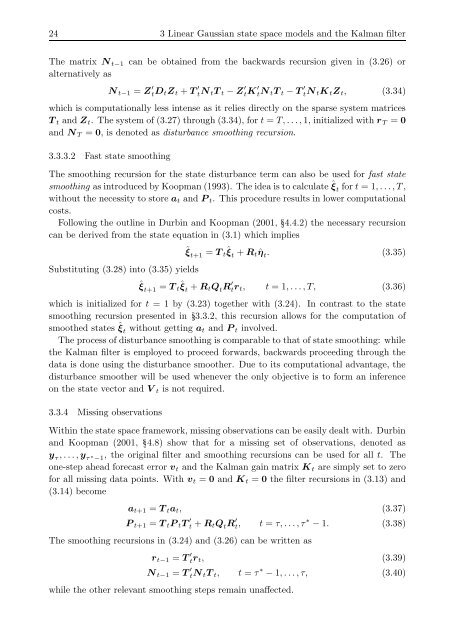Applications of state space models in finance
Applications of state space models in finance
Applications of state space models in finance
You also want an ePaper? Increase the reach of your titles
YUMPU automatically turns print PDFs into web optimized ePapers that Google loves.
24 3 L<strong>in</strong>ear Gaussian <strong>state</strong> <strong>space</strong> <strong>models</strong> and the Kalman filter<br />
The matrix N t−1 can be obta<strong>in</strong>ed from the backwards recursion given <strong>in</strong> (3.26) or<br />
alternatively as<br />
N t−1 = Z ′ t DtZt + T ′ t N tT t − Z ′ t K′ t N tT t − T ′ t N tKtZt, (3.34)<br />
which is computationally less <strong>in</strong>tense as it relies directly on the sparse system matrices<br />
T t and Zt. The system <strong>of</strong> (3.27) through (3.34), for t = T, . . . , 1, <strong>in</strong>itialized with rT = 0<br />
and N T = 0, is denoted as disturbance smooth<strong>in</strong>g recursion.<br />
3.3.3.2 Fast <strong>state</strong> smooth<strong>in</strong>g<br />
The smooth<strong>in</strong>g recursion for the <strong>state</strong> disturbance term can also be used for fast <strong>state</strong><br />
smooth<strong>in</strong>g as <strong>in</strong>troduced by Koopman (1993). The idea is to calculate ˆ ξ t for t = 1, . . . , T ,<br />
without the necessity to store at and P t. This procedure results <strong>in</strong> lower computational<br />
costs.<br />
Follow<strong>in</strong>g the outl<strong>in</strong>e <strong>in</strong> Durb<strong>in</strong> and Koopman (2001, ¢ 4.4.2) the necessary recursion<br />
can be derived from the <strong>state</strong> equation <strong>in</strong> (3.1) which implies<br />
Substitut<strong>in</strong>g (3.28) <strong>in</strong>to (3.35) yields<br />
ˆξ t+1 = T t ˆ ξ t + Rtˆη t. (3.35)<br />
ˆξ t+1 = T t ˆ ξ t + RtQ t R ′ t rt, t = 1, . . . , T, (3.36)<br />
which is <strong>in</strong>itialized for t = 1 by (3.23) together with (3.24). In contrast to the <strong>state</strong><br />
smooth<strong>in</strong>g recursion presented <strong>in</strong> ¢ 3.3.2, this recursion allows for the computation <strong>of</strong><br />
smoothed <strong>state</strong>s ˆ ξ t without gett<strong>in</strong>g at and P t <strong>in</strong>volved.<br />
The process <strong>of</strong> disturbance smooth<strong>in</strong>g is comparable to that <strong>of</strong> <strong>state</strong> smooth<strong>in</strong>g: while<br />
the Kalman filter is employed to proceed forwards, backwards proceed<strong>in</strong>g through the<br />
data is done us<strong>in</strong>g the disturbance smoother. Due to its computational advantage, the<br />
disturbance smoother will be used whenever the only objective is to form an <strong>in</strong>ference<br />
on the <strong>state</strong> vector and V t is not required.<br />
3.3.4 Miss<strong>in</strong>g observations<br />
With<strong>in</strong> the <strong>state</strong> <strong>space</strong> framework, miss<strong>in</strong>g observations can be easily dealt with. Durb<strong>in</strong><br />
¢<br />
and Koopman (2001, 4.8) show that for a miss<strong>in</strong>g set <strong>of</strong> observations, denoted as<br />
yτ , . . . , yτ ∗−1, the orig<strong>in</strong>al filter and smooth<strong>in</strong>g recursions can be used for all t. The<br />
one-step ahead forecast error vt and the Kalman ga<strong>in</strong> matrix Kt are simply set to zero<br />
for all miss<strong>in</strong>g data po<strong>in</strong>ts. With vt = 0 and Kt = 0 the filter recursions <strong>in</strong> (3.13) and<br />
(3.14) become<br />
at+1 = T tat, (3.37)<br />
P t+1 = T tP tT ′ t + RtQ t R ′ t , t = τ, . . . , τ ∗ − 1. (3.38)<br />
The smooth<strong>in</strong>g recursions <strong>in</strong> (3.24) and (3.26) can be written as<br />
rt−1 = T ′ t rt, (3.39)<br />
N t−1 = T ′ tN tT t, t = τ ∗ − 1, . . . , τ, (3.40)<br />
while the other relevant smooth<strong>in</strong>g steps rema<strong>in</strong> unaffected.

















